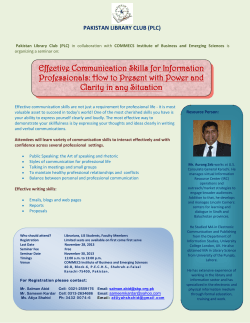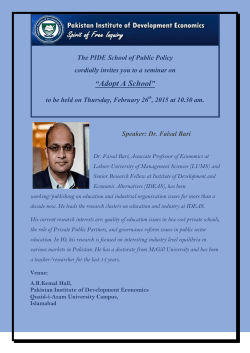
PDF Report (English)
February 2015 GP* gallup Gallup Pakistan HR Newsletter enhancing performance through empirical understanding of HR issues IN THIS EDITION Page 3 Gender Equality at Workplace: A Case of Pakistani Women Reading Time: 1 min Page 4 Centered Leadership: How Talented Women Thrive Reading Time: 1 min Page 5 Women Rising: The Unseen Barriers Reading Time: 3 mins * Disclaimer: Gallup Pakistan is not related to Gallup Inc. headquartered in Washington D.C. USA. We require that our surveys be credited fully as Gallup Pakistan (not Gallup or Gallup Poll). We disclaim any responsibility for surveys pertaining to Pakistani public opinion except those carried out by Gallup Pakistan, the Pakistani affiliate of Gallup International Association. For details on Gallup International Association see website: www.gallup-international.com Welcome to Gallup Pakistan’s 8th edition of a series of HR Newsletters. In this series we principally aim to encourage empirical understanding of HR problems faced by organizations today. By disseminating international and local research findings, Gallup Pakistan aspires to create a knowledge hub that HR practitioners in Pakistan can benefit from. In this regard, we would be borrowing extensive research from other member countries as well. In this edition we endeavor to bring to our readers an understanding of Gender in HR including the current scenario in Pakistani work places, the barriers faced by women leaders at the workplace, and tips for HR managers to help their female employees overcome these barriers. Our first piece is a statistical situation analysis extracted from “Gender Equality at Workplace: A Case of Pakistani Women” in SAARC Journal Of Human Resource Development 2013. The second piece is a five-dimensional leadership model for women extracted from McKinsey&Company „s “Centered Leadership: How Talented Women Thrive”. The final article is “Women Rising: The Unseen Barriers” from the Harvard Business Review which pinpoints the problems in development of women leaders and offers three simple solutions. Don’t forget, your valuable suggestions and ideas are much awaited and appreciated. Also, we are open for partnerships with other teams working in similar domain. We look forward to a successful journey. Gallup Pakistan Team Bilal Gilani Umar Taj Maham Saleem Malika Shahbaz 1 Contributor: SAARC Journal Of Human Resource Development 2013 Gender Equality at Workplace: A Case of Pakistani Women* Situation Analysis • Total Labor Force in Pakistan 53.84 million • Male Labor Force Participation • Female Labor Force Participation 81.9% 24.4% • Ranking in terms of Global Gender Gap Index 135 out of 136 countries • Only 2 out of 14 leading Pakistani companies considered female friendly workplaces PAKISTAN • Total Employed Labor 57.24 million • Women form 4.6% of Board Members of Pakistani companies. *This article can be accessed at: http://www.shrdc.org/doc/sjhrd/2013/8.%20farhat.pdf 2 Contributor: Joanna Barsh, Susie Cranston, and Rebecca A. Craske Centered Leadership: How Talented Women Thrive* Women start careers in their professions with the same level of intelligence, education, and commitment as men. Yet comparatively few reach the top echelons. The authors have interviewed over 85 women globally (and a few good men) who are successful in diverse fields to learn what drives and sustains successful female leaders. From the interviews and other research, they have distilled a leadership model comprising five broad and interrelated dimensions: Meaning, or finding your strengths and putting them to work in the service of an inspiring purpose Managing energy, or knowing where your energy comes from, where it goes, and what you can do to manage it Positive framing, or adopting a more constructive way to view your world, expand your horizons, and gain the resilience to move ahead even when bad things happen Connecting, or identifying who can help you grow, building stronger relationships, and increasing your sense of belonging Engaging, or finding your voice, becoming self-reliant by accepting opportunities and their inherent risks and collaborating with others *This article has been extracted from McKinsey Online resource and can be accessed at: http://www.mckinsey.com/insights/leading_in_the_21st_century/centered_leadership_how_talented_women_thrive 3 Contributors: Herminia Ibarra, Robin Ely, and Deborah Kolb Women Rising: The Unseen Barriers* Becoming a leader involves a fundamental identity shift. Organizations undermine this process when they advise women to seek leadership roles without also addressing practices that communicate a mismatch between how women are seen and the qualities and experiences people tend to associate with leaders. Traditional high-potential mentoring, and leadership education programs are necessary but not sufficient. PEOPLE BECOME LEADERS BY INTERNALIZING A LEADERSHIP IDENTITY AND DEVELOPING A SENSE OF PURPOSE. LEADERSHIP IDENTITY: As a person’s leadership capabilities grow, high-profile, challenging assignments become more likely, giving the person the fortitude to experiment with unfamiliar behaviors and new ways of exercising leadership. BECOMING A LEADER SENSE OF PURPOSE: Effective leaders develop a sense of purpose by pursuing goals that align with their personal values and advance the collective good. Such leaders are seen as authentic and trustworthy because they are willing to take risks in the service of shared goals. *This article has been extracted from Harvard Business Review resource and can be accessed at: https://hbr.org/2013/09/women-rising-the-unseen-barriers 3 Despite a lack of discriminatory intent, subtle, “second-generation” forms of workplace gender bias can obstruct the leadership identity development of a company’s entire population of women. Three actions are proposed to support women’s access to leadership positions. 1. Educate Everyone About Second-Generation Gender Bias Feeling less connected to one’s male colleagues, being advised to take a staff role to accommodate family, finding oneself excluded from consideration for key positions—all these situations reflect work structures and practices that put women at a disadvantage. When women recognize the subtle and pervasive effects of second-generation bias, they feel empowered, not victimized, because they can take action to counter those effects. 2. Create Safe “Identity Workspaces” In the upper tiers of organizations, women become increasingly scarce, which heightens the visibility and scrutiny of those near the top, who may become risk-averse and overly focused on details and lose their sense of purpose. Gender stereotypes may color evaluators’ perceptions, subjecting women to double binds and double standards. *This article has been extracted from McKinsey Online resource and can be accessed at: https://hbr.org/2013/09/women-rising-the-unseen-barriers SECOND-GENERATION GENDER BIAS Research is investigating “second-generation” forms of gender bias which erect powerful but subtle barriers for women that arise from organizational structures, practices, and patterns of interaction that inadvertently put women at a disadvantage. • A paucity of role models for women: Aspiring leaders need role models whose styles and behaviors they can experiment with and evaluate according to their own standards and others’ reactions. • Gendered career paths and gendered work: Many entrenched organizational structures and work practices were designed to fit men’s lives and situations at a time when women made up only a very small portion of the workforce. • Women‟s lack of access to networks and sponsors because of differences in men’s and women’s organizational roles and career prospects, along with their proclivity to interact with others of the same gender, result in weaker networks for women. • Double binds: The mismatch between conventionally feminine qualities and the qualities thought necessary for leadership puts female leaders in a double bind. 3 Creating a safe setting—a coaching relationship, a women’s leadership program, a support group of peers—in which women can interpret these messages is critical to their leadership identity development. These connections are especially important when women are discussing sensitive topics such as gender bias or reflecting on their personal leadership challenges, which can easily threaten identity and prompt them to resist any critical feedback they may receive. 3. The Importance of Leadership Purpose To manage the competence-likability trade-off, women are taught to downplay femininity, or to soften a hard-charging style, or to try to strike a perfect balance between the two. But the time and energy spent on managing these perceptions can ultimately be self-defeating. Overinvestment in one’s image diminishes the emotional and motivational resources available for larger purposes. Anchoring in purpose enables women to redirect their attention toward shared goals and to consider who they need to be and what they need to learn in order to achieve those goals. *This article has been extracted from McKinsey Online resource and can be accessed at: https://hbr.org/2013/09/women-rising-the-unseen-barriers 3 Copyright The materials quoted in this newsletter have been picked from various internet sources. All possible attempt has been made to make sure that no copyrighted material is used in this document. In case if there is an issue relating to Copyright, the publishers of this newsletter will be happy to remove the content immediately. Disclaimer Gallup Pakistan is not related to Gallup Inc. headquartered in Washington D.C. USA. We require that our surveys be credited fully as Gallup Pakistan (not Gallup or Gallup Poll). We disclaim any responsibility for surveys pertaining to Pakistani public opinion except those carried out by Gallup Pakistan, the Pakistani affiliate of Gallup International Association. For details on Gallup International Association, see website: www.gallup-international.com IN NO EVENT SHALL Gallup Pakistan OR ITS AGENTS OR OFFICERS BE LIABLE FOR ANY DAMAGES WHATSOEVER (INCLUDING, WITHOUT LIMITATION, DAMAGES FOR LOSS OF PROFITS, BUSINESS INTERRUPTION) ARISING OUT OF THE USE OF OR INABILITY TO USE THE MATERIALS. As a user of this report, you acknowledge and agree that any reliance upon, or use of any information made available through this Report shall be entirely at your own risk. Subject to any implied terms which cannot be excluded by law, Gallup Pakistan and its related entities (including any directors, officers, employees and agents) shall not be liable for any loss or damage, whether direct or indirect, and however caused, to any person arising from the use of (or reliance upon) information provided on and made available through this Report. Please send all correspondence to HR Newsletter Editorial Team, Email: newsletter.hr@gallup.com.pk Join us to stay updated www.gallup.com.pk
© Copyright 2025











